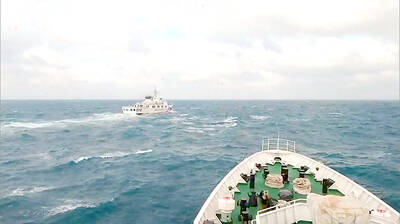The Executive Yuan is only giving the Ministry of National Defense US$3.7 billion for the upgrade of the nation’s ageing F-16 aircraft, the Taipei Times has learned.
As a result of that decision, the ministry has told the air force that it cannot afford to spend US$5.1 billion on the upgrade package, notified to US Congress in September last year, for its 145 F-16A/Bs.
The Times was also informed that a decision has been made not to replace the aircraft’s F-100-PW-220 engines with F-100-PW-229, work that would have cost an estimated US$1.35 billion.
The air force is currently negotiating with US contractors and trying to determine whether to upgrade fewer aircraft or to limit the items included in the upgrades. Consensus on the best possible plan has yet to be reached.
According to a source close to the negotiations, two scenarios are emerging. The first would involve the upgrade of all 145 F-16A/Bs, but to a lesser standard than that proposed in the Sept. 21 notification, or with smaller quantities of armaments.
Although Washington has yet to commit to selling Taiwan the more advanced F-16C/D, the upgrade included an impressive array of advanced weapons systems, including 176 Active Electronically Scanned Array (AESA) radars; 176 Embedded Global Positioning System Inertial Navigation Systems; 176 ALQ-213 Electronic Warfare Management systems; 140 AIM-9X Sidewinder missiles; 16 GBU-31V1 Joint Direct Attack Munitions (JDAM) kits; 80 GBU-38 JDAM kits; and Dual Mode/ Global Positioning System Laser-Guided Bombs — 16 GBU-10 Enhanced PAVEWAY IIs or GBU-56 Laser JDAM, 80 GBU-12 Enhanced PAVEWAY IIs or GBU-54 Laser JDAMs, and 16 GBU-24 Enhanced PAVEWAY IIIs.
The second — and reportedly likeliest — scenario would involve a modest upgrade for only a number of aircraft, with potential for a second round in future. Initial estimates for the upgrade of all 145 aircraft put it at 10 years, a period during which the air force is expected to retire the obsolete F-5 and a number of Mirage 2000s.
Lockheed Martin Corp, the maker of the F-16, appears to be regarded by the air force as the only candidate to perform the avionics upgrades and weapons systems integration, despite a stipulation by the legislature that to ensure the proper use of government public resources, the Letter of Agreement (LOA) for the upgrade package — which is expected to be signed in April — should not specify any supplier and must request that the US team perform an open competition.
BAE Systems is competing with Lockheed for the upgrade, in many ways similar to the one for Taiwan, of 135 KF-16C/Ds for the South Korean air force. Seoul is expected to announce its decision in May or June.
Given that lowering costs appears to be the main consideration for the ministry, industry sources argue that rather than rush into signing the LOA in April and cut back on acquisitions of much-needed weapons to fit the US$3.7 billion mould, Taipei could benefit from waiting to see the outcome of the bidding process in South Korea, which could lead to reduced costs.
Representatives from Lockheed and Raytheon Corp, the other major contractor in the upgrade program and maker of the AESA radar, were unavailable for comment yesterday.

Auckland rang in 2026 with a downtown fireworks display launched from New Zealand’s tallest structure, Sky Tower, making it the first major city to greet the new year at a celebration dampened by rain, while crowds in Taipei braved the elements to watch Taipei 101’s display. South Pacific countries are the first to bid farewell to 2025. Clocks struck midnight in Auckland, with a population of 1.7 million, 18 hours before the famous ball was to drop in New York’s Times Square. The five-minute display involved 3,500 fireworks launched from the 240m Sky Tower. Smaller community events were canceled across New Zealand’s

The Ministry of Foreign Affairs (MOFA) yesterday said it is closely monitoring developments in Venezuela, and would continue to cooperate with democratic allies and work together for regional and global security, stability, and prosperity. The remarks came after the US on Saturday launched a series of airstrikes in Venezuela and kidnapped Venezuelan President Nicolas Maduro, who was later flown to New York along with his wife. The pair face US charges related to drug trafficking and alleged cooperation with gangs designated as terrorist organizations. Maduro has denied the allegations. The ministry said that it is closely monitoring the political and economic situation

UNRELENTING: China attempted cyberattacks on Taiwan’s critical infrastructure 2.63 million times per day last year, up from 1.23 million in 2023, the NSB said China’s cyberarmy has long engaged in cyberattacks against Taiwan’s critical infrastructure, employing diverse and evolving tactics, the National Security Bureau (NSB) said yesterday, adding that cyberattacks on critical energy infrastructure last year increased 10-fold compared with the previous year. The NSB yesterday released a report titled Analysis on China’s Cyber Threats to Taiwan’s Critical Infrastructure in 2025, outlining the number of cyberattacks, major tactics and hacker groups. Taiwan’s national intelligence community identified a large number of cybersecurity incidents last year, the bureau said in a statement. China’s cyberarmy last year launched an average of 2.63 million intrusion attempts per day targeting Taiwan’s critical

‘SLICING METHOD’: In the event of a blockade, the China Coast Guard would intercept Taiwanese ships while its navy would seek to deter foreign intervention China’s military drills around Taiwan this week signaled potential strategies to cut the nation off from energy supplies and foreign military assistance, a US think tank report said. The Chinese People’s Liberation Army (PLA) conducted what it called “Justice Mission 2025” exercises from Monday to Tuesday in five maritime zones and airspace around Taiwan, calling them a warning to “Taiwanese independence” forces. In a report released on Wednesday, the Institute for the Study of War said the exercises effectively simulated blocking shipping routes to major port cities, including Kaohsiung, Keelung and Hualien. Taiwan would be highly vulnerable under such a blockade, because it